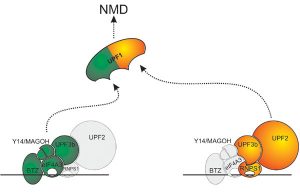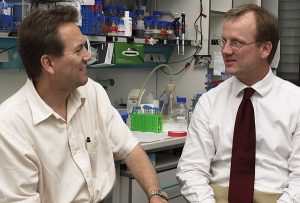Defusing dangerous mutations
Mutations in genes are the basis of evolution, so we owe our existence to them. Most mutations are harmful, however, because they cause cells to build defective proteins. So cells have evolved quality control mechanisms that recognize and counteract genetic mistakes. Now scientists of the Molecular Medicine Partnership Unit [MMPU], a laboratory operated jointly by the European Molecular Biology Laboratory [EMBL] and the University of Heidelberg, have discovered new features of a key quality-control mechanism in our cells. These insights into Nonsense-Mediated Decay [NMD], a process by which cells destroy potentially harmful molecules, promise to clarify our understanding of how some mutations lead to disease. The work appears in the October issue of Molecular Cell.
Both healthy and damaged proteins begin as instructions in genes. Cells read this information and create an RNA molecule, a template that will be used to create proteins. RNAs usually contain extra bits of code that have to be cut out before they can be used. During this cut-and-paste operation, cells attach a group of molecules called the exon junction complex [EJC] to the RNA. An RNA made from a mutant gene usually has an EJC in the wrong position, which activates NMD and destroys the RNA before it can be used to make flawed proteins.
Andreas Kulozik and Matthias Hentze, who jointly run the MMPU, have now discovered that the EJC can be put together from different components, and this influences how the cell recognizes and deals with defects.
“Previously it was believed that animal cells had one standard type of EJC ‘machine’ which alerted cells to errors and activated NMD,” Hentze says. “In the current study we removed one of the components of this machine, a protein called UPF2, and watched how the cell responded. We discovered that there are at least two kinds of NMD: one requires UPF2 and the other does not.”
The presence or absence of UPF2 changes the composition of the EJC, giving it different surfaces for other molecules to grip onto. This affects the way that another component, called UPF1, fits onto the machine. UPF1 is directly responsible for calling up the NMD machinery. The study shows that UPF1 can be mounted on both EJC types; the final effect is the same – to efficiently break down faulty RNAs.
Niels Gehring, who headed the project, did extensive studies with colleagues in the MMPU to understand exactly how the pieces of the EJC fit together. “By slightly altering some of the components, we could change the way they snapped onto the RNA and each other,” Gehring says. “This gave us a very detailed look at the step-wise way in which the EJC can be assembled in two different ways, and what that means for NMD.”
Understanding this process should shed new light on some genetic diseases, says Kulozik, a clinical researcher at the University of Heidelberg. “Some mutations manage to escape NMD and go on to cause disease. Until now we’ve thought that there is one road leading to NMD; discovering a second one will obviously give us a much clearer look at how cells deal with errors – or fail to do so.”
“The goal of EMBL and the University in setting up the MMPU was to create a real marriage between basic research and the clinic to help us understand medically-relevant processes,” Hentze says. “The current study is a perfect example, because it takes us all the way from the details of single molecules to an important disease mechanism.”





